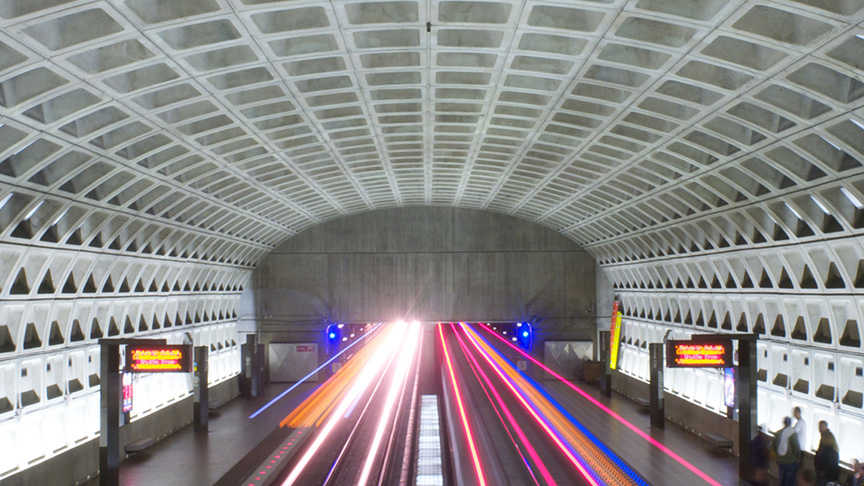You may or may not take your high-speed fiber connection for granted, depending on how much trouble it took to get it. If you look behind the curtain, local and long haul fiber optic connections are run in some pretty predictable places, with a few surprises thrown in for good measure. Knowing where and how your high speed connections are routed can provide insight both into the nature of the arcane business of rights-of-way and (more importantly) the ability to be aware of when and how service can be interrupted.
If you are in a relatively new building in an office park, the "last mile" fiber was more than likely installed during construction and brought to a central office or similar central service point for routing onto a long haul network. Everyone thinks of fiber as something trenched and buried in the ground, but there's a surprising amount of fiber on Ye Olde Telephone Poles. The phone companies like poles because they are already in place and don't have to dig up the ground or result to odd tricks with plumbing and pipes and conduit. In some places, you might find fiber pulled through sewer pipes since every building has that sort of access point.
Last mile fiber is typically vulnerable depending on where it runs. Buried fiber typically encounters a backhoe and/or digging without a call to "Miss Utility" to have underground lines marked before excavation. You'll usually find the backhoe the cause of a major service interruption somewhere once every couple of years or so. Telephone poles are more vulnerable to severe weather and the occasional drunk/poor driver.
Moving beyond the last mile into "metro" style networks around a city or metropolitan area moves us into a broader discussion of rights-of-way. For example, new entrant broadband providers often want to secure the rights to install fiber and other gear on existing telephone poles as a quick way to get into a market without having to dig up a lot of dirt. Incumbent providers typically fall back on existing case law and whatever else they can find to make sure newcomers are delayed as long as possible and pay as much as possible for "access" to existing infrastructure.
Life gets more interesting when someone figures out how to get an exclusive and unique deal on a fiber deal -- typically one undervalued by the holder of the right-of-way to a piece of transportation infrastructure, such as a local subway line or highway. Back in the 1990s, the Washington D.C. area Metro system accepted a deal with MFS to install fiber along 100 plus miles of subway tunnel and above-ground tracks. MFS agreed to do this for "free" in exchange for installing a video camera system and exclusive fiber rights for about 20 or so years. It was a sweetheart deal for MFS at the time and there was little hint of the broadband boom driven by Internet growth.
Fast forward two decades with Verizon now owning all the former contracts and most of the infrastructure of MFS. In the intervening years, Metro managers became acutely aware of the value of its rights-of-way. Needless to say, Verizon had to pay more than "free" to continue to have access to its fiber.
Railways continue to hold a big chunk of right-of-way for fiber. One of the little-known secrets during the '90s Internet boom was the role of Amtrak -- yes, those guys who run the trains -- in providing a fiber broadband corridor between Washington D.C. to New York City, with major breakout points in Baltimore and Philadelphia; you could get also get Trenton, New Jersey and Wilmington, Delaware if you wanted, but most service providers were content with the four major cities along the route.
Amtrak fiber proved to be a win for all involved. The railroad company brought in needed revenue from the fiber running along the Northeast Corridor tracks while phone and Internet companies got fiber access to the densest markets along the East Coast.
Today, Allied Fiber is following the railways around the U.S. to put more long-haul fiber into the ground along the East Coast from New York City all the way down to Miami. Future builds will move Northeast to Chicago and across the rest of the country, following the railroad fiber rights-of-way tradition started by Amtrak and Southern Pacific Railroad.
The biggest U.S. rights-of-way telecom story can trace its roots back to natural gas. The Williams Companies built not one, but two, national fiber optic networks by running fiber through decommissioned pipelines and along pipeline rights of way: WorldCom and WilTel Communications; the latter network was acquired by Level 3 not too long ago.
Recent talk of local municipalities putting in more natural gas pipelines, as well as new construction of oil and gas pipelines across the U.S. has me wondering if there are other forward-thinking entrepreneurs securing fiber rights and/or putting down dark fiber to take advantage of all the new infrastructure construction in America's latest energy boom.
